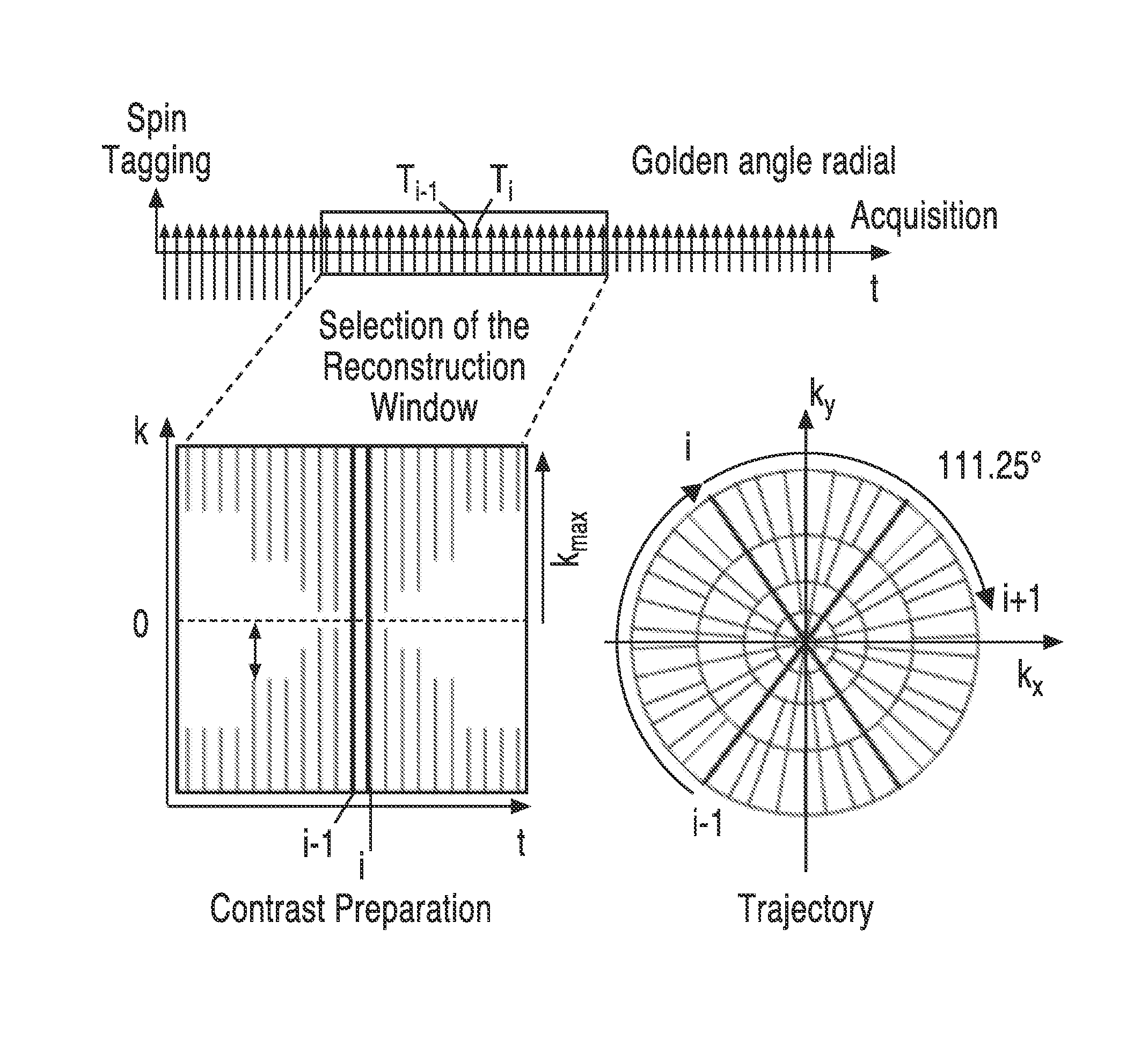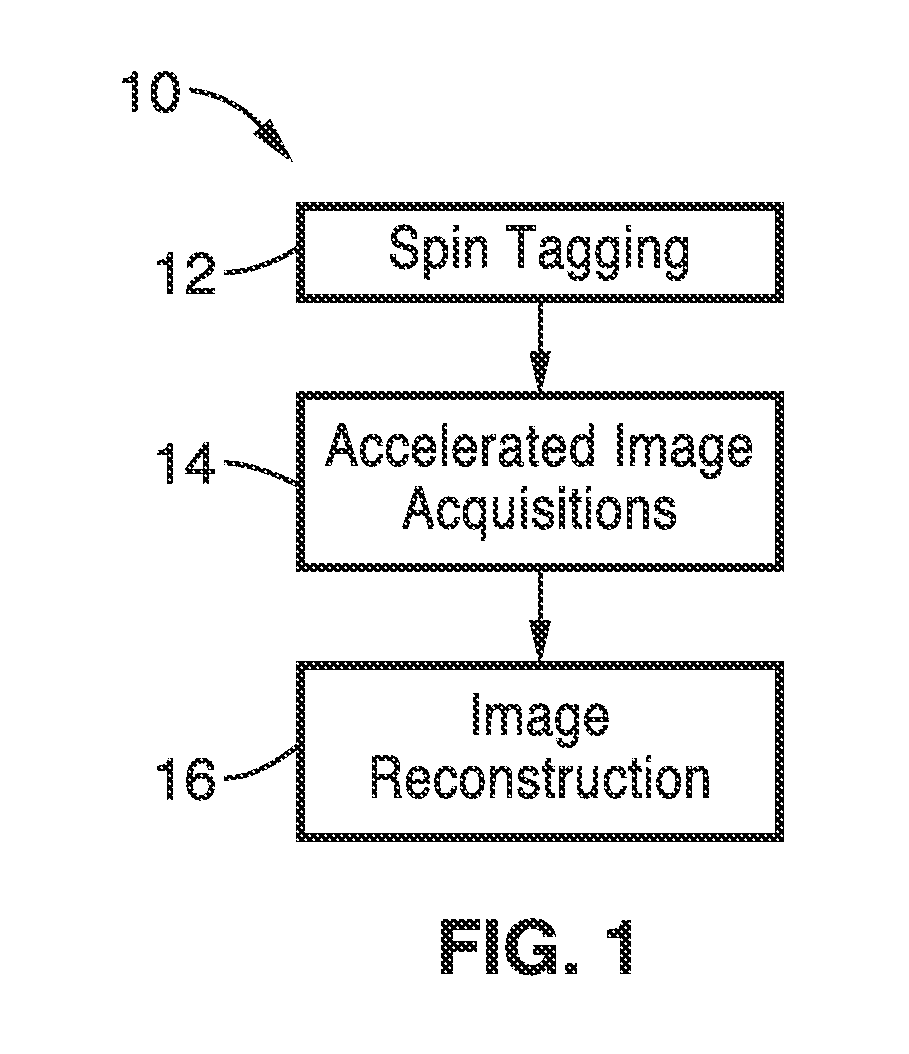Noninvasive 4-d time-resolved dynamic magnetic resonance angiography
a dynamic magnetic resonance and time-resolved technology, applied in the field of magnetic resonance imaging, can solve the problems of invasive dsa procedure, difficult to derive quantitative hemodynamic information using either dsa and/or ce-dmra procedures, and associated risks of allergic and other adverse reactions, and achieve high spatial and temporal resolution, adequate snr, and high degree of efficiency and flexibility
- Summary
- Abstract
- Description
- Claims
- Application Information
AI Technical Summary
Benefits of technology
Problems solved by technology
Method used
Image
Examples
example 1
[0048]In order to demonstrate the functionality of the spin labeling aspects of the invention, a FISP-based spin tagging with alternating radiofrequencies (STAR) labeling sequence was evaluated and the spatial and temporal resolution of the method was optimized in eight healthy volunteers. In another six healthy volunteers, the contrast-to-noise ratio (CNR) and signal-to-noise ratio (SNR) of the STAR based dynamic MR angiography images were compared with those acquired by using a standard Look-Locker echo-planar technique by using the Wilcoxon signed rank test. Finally, one patient with an arteriovenous malformation (AVM) was studied using this technique.
[0049]As shown in the pulse sequence diagrams of FIG. 2A and FIG. 2B, immediately following a section-selective or nonselective hyperbolic secant inversion pulse, a train of 20 dummy radiofrequency pulses with Kaiser Bessel window ramp flip angles (i.e., α / 21, −2α / 21, 3α / 21, . . . , 20α / 21) was applied to minimize transient signal o...
example 3
[0061]The ultrafast 4D dMRA methods were further demonstrated with an embodiment employing a 3D stack-of-stars golden-angle radial acquisition in conjunction with temporal filtering strategies of k-space weighted image contrast (KWIC) to achieve 4D dMRA with high spatial and temporal resolution, adequate SNR, and high temporal fidelity. Dynamic radial acquisition with a golden angle view increment is ideally suited for 4D dMRA, given its high degree of efficiency and flexibility for retrospective dynamic image reconstruction.
[0062]The pulse sequence that was used consisted of a continuous 3D TrueFISP readout following either slice-selective or non-selective inversion pulses. A dynamic 3D radial stack-of-stars sampling with an in-plane view angle increment of θg=111.25° (golden angle) was utilized as illustrated in FIG. 4. A 3D radial stack-of-stars sampling was achieved by taking multiple shots, where each shot represented a slice-encoding step. The imaging parameters were as follow...
example 4
[0066]The diagnostic methods of the invention can be adapted to many different imaging contexts. For example, the methods can be used to estimate vascular compliance or stiffness of the vessel. A reduction in vascular compliance (VC) is a risk factor and / or marker of a number of diseases with high social and economical impact, such as atherosclerosis, hypertension, and diabetes. Aging is also accompanied by a decrease of VC. Currently, VC can be indirectly estimated by measuring aortic pulse wave velocity (PWV) with ultrasound imaging and MRI. To date, however, no method is available for assessing intracranial VC, which is defined by the change in arterial blood volume (ΔBV) due to a given change in arterial blood pressure (ΔBP), i.e., VC=ΔBV / ΔBP.
[0067]It is possible to assess vascular compliance using 4D dMRA by synchronizing the dMRA acquisitions with the systolic and diastolic phases of the cardiac cycle. This was demonstrated by measuring the blood flow velocities in internal ca...
PUM
 Login to View More
Login to View More Abstract
Description
Claims
Application Information
 Login to View More
Login to View More - R&D
- Intellectual Property
- Life Sciences
- Materials
- Tech Scout
- Unparalleled Data Quality
- Higher Quality Content
- 60% Fewer Hallucinations
Browse by: Latest US Patents, China's latest patents, Technical Efficacy Thesaurus, Application Domain, Technology Topic, Popular Technical Reports.
© 2025 PatSnap. All rights reserved.Legal|Privacy policy|Modern Slavery Act Transparency Statement|Sitemap|About US| Contact US: help@patsnap.com



